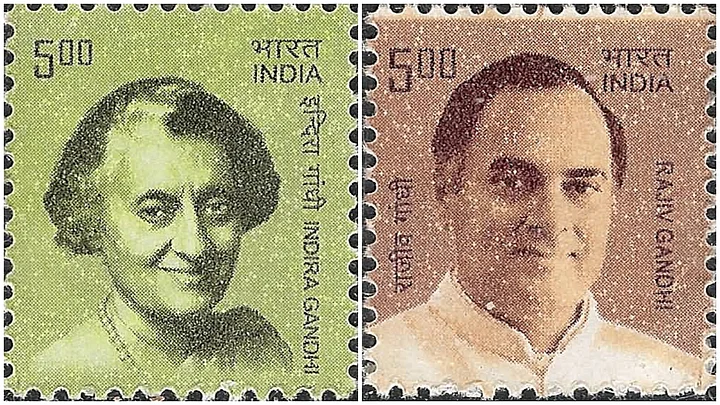An RTI query filed by The Indian Express reveals that the BJP government has discontinued Rs 5 stamps in the ‘Builders of Modern India’ series featuring Indira and Rajiv Gandhi. The Department of Posts (DoP) has reportedly introduced a ‘Makers of India’ series which will feature 24 personalities including Deendayal Upadhyaya, Jayaprakash Narayan, Shyama Prasad Mookerjee and Ram Manohar Lohia.
One could call it a conspiracy to slowly erase the Gandhi surname from public life, but consider this – a 2012 query by RTI activist Ramesh Verma reveals that nearly half, or 27 of 58 centrally sponsored schemes and institutions are named after Nehru, Indira and Rajiv Gandhi. Earlier, a 2009 RTI query had revealed that nearly 450 initiatives and establishments were named after the Nehru-Gandhi family.
The Congress party has been in power for 56 of the 68 years since India gained Independence. While the complete lack of democracy in choosing non-Congress leaders as symbols of government institutions is not entirely surprising, what does raise eyebrows is how even Congress leaders who deserved a lot more credit have been completely eclipsed by the Nehru-Gandhi surname.
Sardar Vallabhai Patel is perhaps the tallest leader in that list, quite literally, now that Narendra Modi has decided to commemorate him with a nearly 600 ft tall statue facing the Sardar Sarovar Dam on the Narmada.
A decisive Home Minister, he unified the 100-odd kingdoms into the newborn State and was crucial to India’s efforts to retain Kashmir. But it took 41 years and the Vajpayee government to confer the Bharat Ratna on the Iron Man of India.
Compare this to Rajiv Gandhi, who was declared a Bharat Ratna in 1991 – two years after he was assassinated. The honour was bestowed on a Prime Minster whose five years in power were mired in controversies that followed the anti-Sikh riots, the Bhopal gas tragedy, the Bofors scandal and even the Shah Bano case.
Differences between Nehru and Patel perhaps stemmed from the fact that Patel enjoyed overwhelming support within the Congress and would’ve been the Congress President and consequently Prime Minister had it not been for Gandhi’s intervention. The two leaders differed on some key issues such as Kashmir’s accession to India and even foreign policy matters as a November 7, 1950 letter from Patel to Nehru signifies.
With the Statue of Unity and other initiatives in Patel’s name, the BJP has certainly resurrected if not entirely appropriated the legacy of the man who banned the RSS.
In his book, The Accidental Prime Minister, Sanjaya Baru reveals how Manmohan Singh wanted to honour PV Narasimha Rao and Atal Bihari Vajpayee with the Bharat Ratna but failed. Instead, the Congress-led government stood by its controversial decision to confer the country’s highest honour on Sachin Tendulkar among others.
In 1991, Rao became the first Congress Prime Minister from outside the Nehru-Gandhi family to serve a full term. It was a turbulent time for the party in the aftermath of Rajiv Gandhi’s assassination. The Soviet Union had just collapsed and ‘socialist’ economies like India were struggling.
At that dark moment in history, Narasimha Rao shocked most pundits by dumping Nehru’s economic model. Large parts of India’s mammoth, sluggish public sector saw disinvestment and privatisation. Rao, with his Finance Minister Manmohan Singh, abolished the License Raj, cut red tape and drew in foreign investment.
Quite simply, he was the father of India’s liberalised economy. By announcing a memorial at the national capital in Rao’s memory, Modi is doing what his predecessor couldn’t.
In his book To the Brink and Back: India 1991 Story, former Union Minister Jairam Ramesh has admitted that his party’s indifference to Narasimha Rao has allowed the BJP to boast of bipartisanship.
Patel and Narasimha Rao existed in different political eras, but appear to have paid the price of taking on Nehru and his legacy respectively.
While leaders like Deen Dayal Upadhyay, Shyama Prasad Mookerjee and Ram Manohar Lohia have been commemorated on stamps, have roads and government institutions named after them, they have not been branded into the collective psyche of our national consciousness.
But to credit the BJP with statesmanship for memorialising Patel and Rao while they phase out Indira and Rajiv Gandhi’s stamps and rename roads and government schemes and institutions is also a stretch.
Like nature, the wheel of political fortunes always turn. With it, the faces on our stamps, the names of the lanes we live in, the stations we travel to and from, and our Bharat Ratnas.
(At The Quint, we question everything. Play an active role in shaping our journalism by becoming a member today.)
